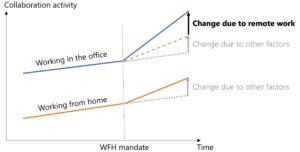The effects of remote work on collaboration among information workers
- Longqi Yang ,
- David Holtz ,
- Sonia Jaffe ,
- Siddharth Suri ,
- Shilpi Sinha ,
- Jeffrey Weston ,
- Connor Joyce ,
- Neha Parikh Shah ,
- Kevin Sherman ,
- Brent Hecht ,
- Jaime Teevan
Nature Human Behaviour |
Prior to the COVID-19, pandemic no more than 5% of Americans worked from home more than three days per week, whereas it is estimated that by April 2020 as many as 37% of Americans were working from home full-time (opens in new tab). Not only did information workers have to adapt to this new way of working, they had to do so in the face of a global pandemic that caused school closures, shelter-in-place orders, and increased overall stress levels. Although it was clear that work patterns had changed during the pandemic, our research team wanted to understand what effects working remotely would have on work patterns once the COVID-19 pandemic was over.
To answer this question, we analyzed data describing the work patterns of Microsoft employees both before and after Microsoft’s firm-wide work from home mandate in March 2020. We knew that there were employees at Microsoft who worked from home before the pandemic. We assumed that any observed change in their behavior after the work from home mandate was not due to working remotely, but due to other factors, many of which were likely COVID-19 related. On the other hand, there were many Microsoft employees who worked in the office prior to the work-from-home mandate. We assumed that any observed change in their behavior was due to a combination of working from home and the same outside factors that affected the employees who had worked from home to begin with. As the figure below shows, if work outcomes for these two groups moved in parallel prior to the pandemic, we could subtract out any difference in behavior between the two groups to isolate the causal effects of working from home.

Overall, we found that the shift to remote work caused the formal business groups and informal communities within Microsoft to become less interconnected and more siloed. Remote work caused the share of collaboration time employees spent with cross-group connections to drop by about 25% of the pre-pandemic level. Furthermore, firm-wide remote work caused separate groups to become more intraconnected by adding more connections within themselves. The shift to remote work also caused the organizational structure at Microsoft to become less dynamic; Microsoft employees added fewer new collaborators and shed fewer existing ones.
Microsoft employees didn’t just change who they worked with, but also how they worked with them. Our results indicate that the shift to firm-wide remote work increased unscheduled call hours but decreased total meetings and call hours by 5% of their pre-pandemic level. This suggests that the increase in meetings many experienced during the pandemic was not due to remote work, but due to the pandemic and related factors. Remote work also increased asynchronous communication, like email and IM. Based on previous research, we believe that the shift to less ‘rich’ communication media may have made it more difficult for workers to convey and process complex information.
Our methodology also allowed us to decompose the overall effect of firm-wide remote work into two separate components: the effects of someone working remotely on their work practices, and the effects of someone working remotely on their collaborators’ work practices. We found that many of the effects of firm-wide remote work were driven as much by effects on collaborators as effects on oneself. This suggests that even if firms were to adopt work arrangements where some employees return to the office, the effects on collaboration patterns would be still be present, albeit somewhat mitigated.
In light of these findings, companies will need to take proactive measures to try to help workers acquire and share new information across groups, so that productivity and innovation are not impacted. Separating the effects of working from home from the effects of COVID-19 requires statistical knowhow. Furthermore, the effects of these policies on company culture and innovation could take years to measure. Because remote and hybrid work are likely to persist even after the pandemic has ended, it is incredibly important to understand how these policies affect the ways that people collaborate with one another.
